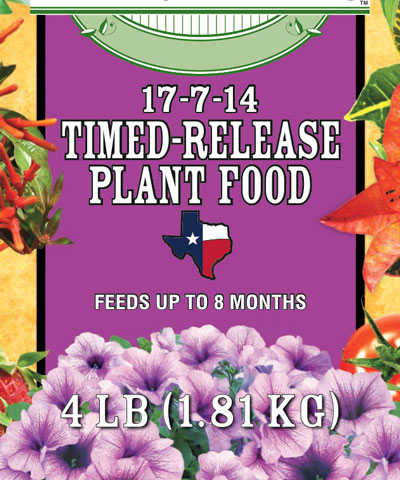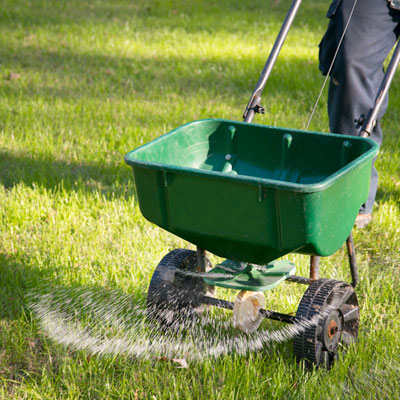Fertilizer Facts and Fantasies

Photo: All plants in this handsome landscape have been fertilized to their own individual needs.
Any product that carries claims of adding nutrients to our soils and our plants’ environments must carry documentation of its claims. It’s a state regulation. That’s a protection we gardeners all should appreciate.
But not all fertilizers are equally effective in stimulating plant growth, so it’s a good plan to have the real facts out there in front of us. Let me present a few details.

Photo: Simple landscapes, properly nourished and carefully tended, can be a delight. And the best news of all: they need not be high-maintenance at all.
Organic or inorganic…which is the better?
In fact, both have their advantages. I’m not going to try to change anyone’s way of thinking, but instead to explain how plants utilize the nutrients we supply to them.
Fact 1: The major elements, nitrogen, phosphorus and potassium move into plants’ roots suspended in water. Before they can do so, they must be broken down into very simple, water-soluble forms. At the point that nitrogen, as one example, enters a plant’s roots, there is no difference in that nitrogen, whether it was produced in a factory, or is the by-product of a cattle feedlot. In that respect, organic and inorganic fertilizers are taken up by plants in exactly the same way – by osmosis in water solution.
Fact 2: Organic fertilizers dissolve (become “available”) much more slowly than inorganic types. That means they’re less likely to cause burning of foliage than inorganic types, but it also means that it will take them much longer to show positive results. Inorganic fertilizers, by comparison, become available for plant use fairly rapidly, so you’ll see the response more quickly.

Photo: Learn to read the guaranteed analysis on each product’s label. Know the importance of each of those elements.
Fact 3: Another prime difference between organic and inorganic plant foods is in their percentage of nutrient content. The three numbers in each product’s analysis represent percentages of nitrogen, phosphorus and potassium. Adding them up, organic fertilizers with analyses of 1-2-1 contain four percent actual nutrients. Inorganic types like 12-12-12 contain 36 percent. 24-0-4 would be 28 percent total nutrients. That makes a big difference in amounts of organic or inorganic plant foods you’ll need to apply to achieve anywhere near the same results.
Fact 4: Organic fertilizers, particularly manures, have high contents of organic matter. That means they are very beneficial in improving our soils. When I talk about bed preparation for annual and perennial flowers, also vegetable gardens, I talk about incorporating several inches of organic matter into the top foot of any Texas soil. A major part of that organic matter is well-rotted manure. So, you get the organic matter and the nutrition, albeit at low levels of nutrients.
Have your soil tested…
Monitor your progress in meeting your plants’ nutrient needs. Have the soil tested every two to four years. Texas A&M has a fine soil testing lab. See http://soiltesting.tamu.edu for details and instructions. Local nurseries also offer soil tests from time to time.
When your soil test comes back, don’t be surprised if it suggests you need to apply only nitrogen – absolutely no phosphorus (middle number of the analysis) and no potassium. Phosphorus (and sometimes potassium) is almost always present in very excessive amounts in most Texas clay soils. It’s going to feel odd to put an all-nitrogen fertilizer around flowering and fruiting plants, but if that’s what the soil test suggests, go with it.

Photo: Uniform distribution of nutrients is critical to a good feeding program. Rotary spreaders make that task a lot easier.
Timing your feedings…
I normally advise people to fertilize in anticipation of upcoming growth, not after it has occurred. You want to have a ready supply or nutrients available for your plants when they’re exerting their most effort in growing.
Most trees and shrubs, vines and groundcovers: early spring, late spring, early fall;
Spring-flowering shrubs and vines: all-nitrogen food immediately after they finish blooming, repeat late spring, early fall (in sandy loam soil, phosphorus may be advised in fall to promote maximum bud set over winter);
Fruit crops: Late winter as growth begins, late spring, early fall;
Annual and perennial flowers: Monthly during peak blooming season;
Vegetables: Two weeks after planting; monthly until harvest;
Common bermuda: Every two months from mid-April through mid-October;
Hybrid bermudas (dwarfs): Monthly mid-April through mid-October;
St. Augustine: Mid-April, early June, early September;
Zoysia: Every two months from mid-April through mid-October;
Buffalograss: Mid-May, mid-September;
Fescue: Mid-September, mid-November, mid-February.
Important side note…
Parts of Texas have had large quantities of rain in the past 10 days. Do not rush to fertilize if soils are waterlogged. You need to water granular fertilizers into the soil, and if there is nowhere for that water to go, you simply must wait. As noted above, it’s too early to be feeding most plants anyway in most of our state. Sit tight and relax.
